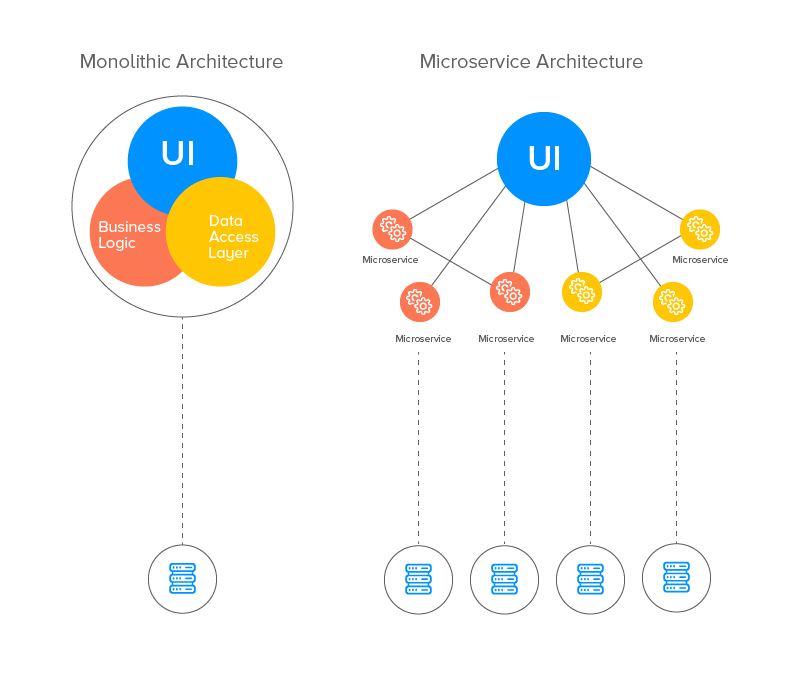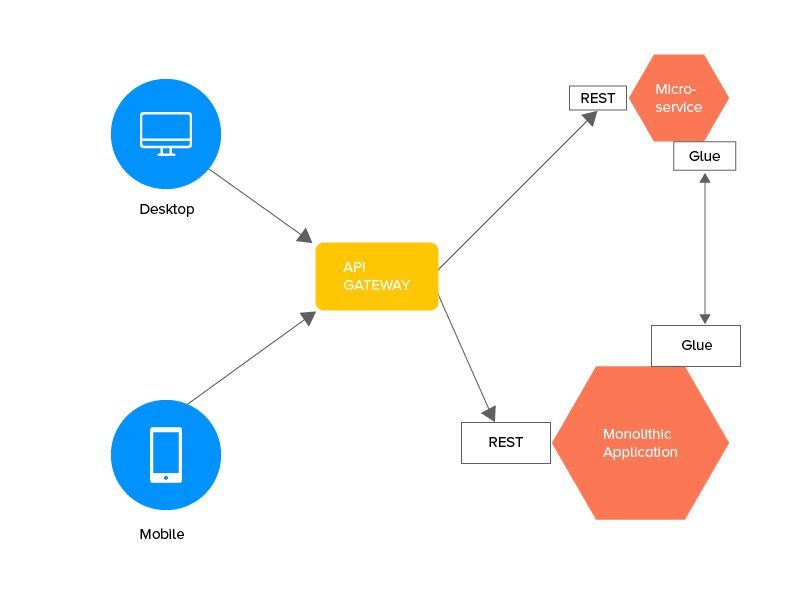Microservices vs Monolithic Architecture: Which is Right for Startups?
In our article about microservice architecture, we have discussed briefly about the topic and why it should be used by business owners in their next project. Now coming back to topic, we will be diving deep into microservices and monolithic architectures.
The debate of Microservices vs monolithic architecture defines a revolutionary shift in how an IT team approaches their software development cycle: Whether they go with the approach that brands like Google, Amazon, and Netflix chose or do they go with the simplicity quotient that a startup which is at the development stage demands.
In this article, we are going to get startups an answer to which backend architecture they should choose when they are starting their journey to become a startup.
Table Of Content:
- What are Microservices Architecture?
- What is Monolithic Architecture?
- Monolithic Architecture Vs Microservices Architecture: Advantages and Disadvantages
- Which One Is Better Monolithic Architecture Vs Microservices Architecture?
- Migrating from a Monolithic Architecture to a Microservice Ecosystem
- Should Startups Use Microservices?
- Conclusion
- FAQs About Microservices vs Monolithic Architecture
What are Microservices Architecture?
Microservices architecture contains a mix of small and autonomous services where every service is self-contained and must be implemented as a single business ability. It is a distinct approach used for development of software systems which focus on developing several single-function modules with clearly-defined operations and interfaces. The approach has become a popular trend in the past several years as more and more Enterprises are looking to become Agile and make a shift towards DevOps.
Components of Microservices architecture that makes it one of the best enterprise architecture:
- The services are independent, small, and loosely coupled
- Encapsulates a business or customer scenario
- Every service is different codebase
- Services can be independently deployed
- Services interact with each other using APIs
With the question of what are microservices architecture now answered, let us move on to look into what is monolithic architecture or what does monolithic mean?
What is Monolithic Architecture?
Monolithic application has a single codebase having multiple modules. The monolith definition includes the modules which in turn are divided into either technical features or business features. The architecture comes with a single build system that helps build complete application. It also comes with a single deployable or executable binary.
Now that we have looked into the monolith definition or what does monolithic mean and what are microservices architecture, let us look into the disadvantages and benefits that both the backend system offers to get an understanding of what separates them from each other.
Monolithic Architecture Vs Microservices Architecture: Advantages and Disadvantages

Advantages of Monolithic Architecture
Zero Deployment Dependencies
An organized and well-documented Monolith architecture makes it possible for Backend developers to not worry about which version would be compatible with which service, how to find which services are present and what they do, etc.
Error Tracing
One of the biggest benefits of monolithic is that all the transactions are logged into one place, making error tracing task a breeze.
No Silos
The one factor that works in the favour of monolithic in the microservices vs monolithic architecture debate is absence of silos. It becomes very easy for the developers to work on multiple parts of the app for they are all structured similarly, using the same tools, which makes it okay to have no prior distributed computing knowledge.
Cross-cutting concerns:
Spending time in defining the services which do not bleed in each other’s time is the time that you can actually spend in developing things that help the customers.
Shared Code:
No shared libraries where the complete scope needed for services to operate is sent along each request.
Limitations of Monolithic Architecture
Lack of Flexibility:
In monolithic and microservices, Monolithic architectures are not flexible. You cannot use different technologies when you have incorporated Monolithic. The technology stack which have been decided at the beginning have to be followed throughout the project, making upgrades a next to impossible task.
Development Speed:
Microservices speed development process is famous when you compare microservices architecture vs monolithic architecture. Development is very slow in monolithic architecture. It can be very difficult for team members to understand and then modify the code of large monolithic applications. Additionally, as the size of codebase increases, the IDE gets overloaded and gets slower. All of this results in a slowed down app development speed.
Difficult Scalability:
Scaling monolithic applications becomes difficult when the apps becomes large. While developers can develop new instances of monolith and load balancer to distribute the traffic to new instances, monolithic startup architecture cannot scale with the increasing load.
Now that we have understood the pros and cons of Monolithic architecture in difference between monolithic vs microservices, let’s move on to the pros and cons of microservices.
Benefits of Microservices Architecture
- The biggest advantages of microservices over monolithic in the difference between microservices and monolithic architecture is that it handles complexity issues by decomposing the app into manageable service set that are faster to develop and easier to maintain and understand.
- Another of the benefits of microservices is that it enables independent service development through a team which is focused on the particular service, which makes the ideal choice of businesses that work with an Agile development approach.
- It lowers the barrier of adopting newer technologies as the developers have the freedom to choose whatever technology that makes sense to their project.
- Another advantage of microservices over monolithic is that, it makes it possible for every microservice to be deployed individually. The result of which is that continuous deployment of complex application becomes possible.
Drawbacks of Microservices Architecture
- Microservices add complexity to a project simply by the fact that the microservices application is a distributed system. To solve the complexities, developers have to select and implement inter-process communication that is based on either RPC or messaging.
- They work with partitioned database architecture. The business transactions which update multiple business entities inside the microservices application also have to update different databases that are owned by multiple services.
- It is a lot more difficult to implement changes which span across multiple services. While in case of Monolithic architecture, an app development agency only have to change the corresponding modules, integrate all the changes, and then deploy them all in one go.
- Deployment of a microservice application is very complex. It consists of a number of services, which individually have multiple runtime instances. In contrast, a monolithic application is deployed on a set of identical servers behind load balancer.
The benefits and limitations are prevalent in both monolithic and microservices architecture. This makes it extremely difficult for a startup to gauge which backend architecture to incorporate in their journey, whether to choose monolith startup or microservices startup.
Let us help you.
Which One Is Better Monolithic Architecture Vs Microservices Architecture?
The fact that both the approaches come with their own set of pros and cons are a sign that there is no one size fits all methodology when it comes to choosing a backend architecture. But there are a few questions that can help you decide which is the right direction to head into.
Are You Working in a Familiar Sector?
When you work in an industry where you know the veins of the sector and you know the demands and the needs of the customers, it becomes easier to enter into the system with a definite structure. The same, however, is not possible with a business that is very new in the industry, for the amount of looming doubts is much greater.
So, the use of microservice architecture in app development is best suited in cases where you know the industry inside out. If that is not the case, go with a monolithic approach to develop your app. If you are still confused then go with microservices monolithic comparison for a better decision.
How Prepared is Your Team?
Is your team aware of the best practices for implementing microservices? Or are they more comfortable with working around the simplicity of monolithic? Will your team and your business offering expand in the coming time? You will have to find answers to all these questions to gauge whether the people who have to work on a project are even ready to migrate.
What is Your Infrastructure Like?
Everything from the development to the deployment of a monolithic web application would require a cloud-based infrastructure. You will have to make use of Amazon AWS and Google Cloud for deploying even tiny elements. While cloud technologies make the process easier, The idea of setting up database server for every other microservice and then scaling out is something that startup entrepreneur might not be comfortable with.
Have you Evaluated the Business Risk?
More often than not, businesses take microservices’ side in the Microservices vs Monolithic Architecture thinking it is the right thing for their business. What they forget to factor in is the chance that their application might not become as scalable as they are optimistically expecting and they might have to suffer the risks of adding a highly scalable system in their process.
Here is a short list of pointers that would help you make the decision of choosing to opt for software development processes with microservices vs monolithic architecture:
When to Choose Monolithic Architecture?
- When your team is at a founding stage
- When you are developing a proof of concept
- When you have no experience in microservices
- When you have experience in the development of solid frameworks, like Ruby on Rails, Laravel, etc.
When to Choose Microservices Architecture?
- You need independent, quick delivery service
- You need to extend your team
- Your platform need to be extremely efficient
- You don’t have a tight deadline to work with
Migrating from a Monolithic Architecture to a Microservice Ecosystem

The right approach for migrating a monolithic architecture to a microservice ecosystem is to divide the monolith processes and turn them into microservices. The result of this is a two-factor plan:
- Identification of existing monolithic elements which can get decoupled
- A validation that the new functionality can be developed as microservice
One of the main challenges that can emerge when initiating the migration from a monolithic architecture to a microservice architecture is to design and create an integration between existing systems and a new microservice. A solution for this can be to add a glue code which allows them to connect later, something like an API.
API gateway can also help in combining multiple individual service calls in one coarse-grained service, and this in turn would help reduce the integration cost with a monolithic system.
In the next section, let’s learn how does microservices affect startups and should small businesses consider using microservices?
Should Startups Use Microservices?
Microservices for startups- Startups or small businesses should consider making use of microservices if they have enough assets and resources to handle the related complexities.
Clearly, microservices come with an expansion in complexities. Thus, a startup should have the assets to address these intricacies or risk presenting greater issues than it settles for.
For startups, you can make use of microservices when:
- The services are third-party or cloud-native, or
- The microservice runs on serverless infrastructure
Microservices when done well unquestionably offer a wide assortment of advantages over traditional models/ architectures, and this makes them extremely appealing. There’s additionally an immense measure of articles covering the triumphs that companies, for example, Netflix and Amazon have had utilizing them. Significantly there are less articles on what happens when microservices turn out badly and the expense of taking care of business.
Consolidate this with a great deal of programming that individuals’ long to do ‘the cool’ stuff, and it’s easy to come to the end result that each startup ought to be going the microservice route, and that disappointment is the lone objective on the off chance that you don’t.
The goal of a startup should be to deliver a product while building and maintaining as few original components as possible. Modern infrastructure has made that easy! Kubernetes, Docker, vendors, and serverless stacks make it very easy to build an application which is simply a collection of OSS, hosted, and third-party solutions. A webapp might use:
The objective of a startup should be to deliver a product while constructing and keeping up as few original components as could be expected. Modern foundation has made that simple!
Conclusion
When you compare microservices architecture vs monolithic architecture, you will find the former being a hot trend. Every entrepreneur wants to say that their app is based on this architecture. But the temptation to focus only on the problems of monolithic architecture and abandon the architecture should be measured against the actual value of microservice architecture.
The right approach would be to develop new apps using a monolithic approach and move to microservices only when the justification of the move is backed by proper metrics like performance monitoring.
For established businesses, microservices tend to be avenues for continuous deployment, team based development, and an agility to shift to new technologies. But for startups, or companies that are just starting, adopting microservices can impact the software project success negatively if not implied properly.
It is better for startups to take help from a startup app development company or mobile app development company for startups to have a smooth development process. Appinventiv is one of the known and best startup app development company in USA, that helps startups and small businesses with their projects and new technologies.
FAQs About Microservices vs Monolithic Architecture
Q. What is the Purpose of Microservices?
The Microservice architectures allow you to divide the application into separate independent services, where each of them are managed by different groups in the software development agency. This way, the responsibility gets divided and the application is developed and deployed at a much faster rate.
Q. Does moving from a monolith to a Microservice architecture help with resilience?
Yes. Since microservices enable developers to handle multiple parts of the project at the same time in a streamlined manner, it becomes much easier to identify issues and solve them within time. Something that is next to impossible in case of Monolithic architecture where it is impossible to add new technologies or change the process, mid project.
Q. What is the difference between monolith vs microservices approach?
The difference in monolith vs microservices architecture is the difference of approaches. While in case of Monolithic architecture, there is a single build system, Microservices come with multiple build systems, which makes development and deployment of an application faster.
Q. When To Choose Microservices Over Monolithic Architecture
When it comes to microservices monolithic comparison, the choice of going with microservices over monolithic architecture can be decided upon these factors:
- When you require an independent delivery service
- When you have to extend the team
- When you have to make an efficient platform
- When you do not have a tight deadline

strategies your digital product..




